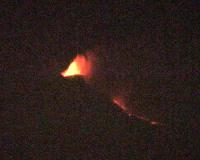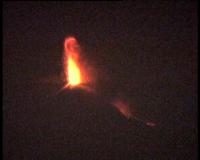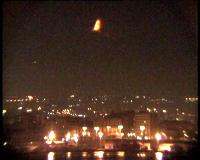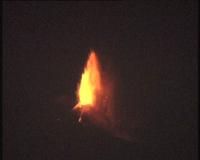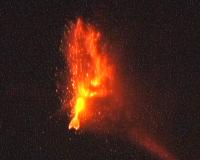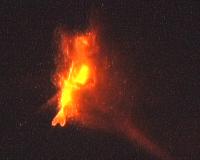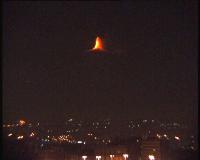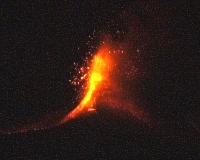|
|
Do you
plan to visit Etna in the near future?
Check the weather
forecasts for the Etnean area!
NEW:
Excursions to the Etna area,
read more here!
The
Etna telecamera is maintained by the
"Sistema Poseidon"
and there is no relationship of any kind with this site and its author.
The Poseidon web site is in Italian, and the link to the telecamera
is changed frequently, so that it is not indicated here (click on
"Etna live cam" on the Poseidon home page). Please note
also that all information provided on the present page (and the archived
Etna news pages) is informal, based on personal observations, and
is not intended to substitute, or compete with, the news bulletins
now issued regularly at the Poseidon web site.
|
WARNING:
Access to the summit area is HIGHLY
DANGEROUS. Violent eruptive episodes are occurring
frequently at the Southeast Crater, and heavy showers of tephra
(including clasts tens of centimeters in diameter) may occur
up to several kilometers away. Lava may also arrive rapidly
at up to 1.5 km of distance from the crater. Besides this, weather
conditions are often unstable. Strong wind, snow or rain and
clouds are occuring frequently in the summit area, and one can
get easily lost. Excursions should be made only with the mountain
guides who can be contacted at the cable car (near the Rifugio
Sapienza) on the southern side of Etna, or (during the summer)
at the hotel "Le Betulle" at Piano Provenzana, on
the northern side.
|
9
April 2000 update.
No confirmed eruptive activity has occurred at the SE Crater
since 6 April. Bad weather has prevented any visual observations on
9 April, and it is thus not known whether there has been another eruptive
episode at the crater.
In the meantime you may get an overview of the unusual sequence of
eruptive episodes at the SE Crater since 26 January on a new
page, which also contains numerous photos not available before
on this site. Photos of the 6 April paroxysmal eruptive episode are
shown below.
|
Photos
of the 6 April 2000 paroxysm:
The view from the southern flank of Etna
These
photos were taken by Boris Behncke
|
 1
1 |
 2
2 |
 3
3 |
Initial
phase of the eruptive episode at between about 1200 and 1205
h on 6 April, seen from an area north of Nicolosi (southern
flank of Etna; about 8 km from the SE Crater). The activity
consists of discrete Strombolian bursts, which rapidly increase
in strength and frequency
|
 4
4 |
 5
5 |
|
The
photos above were taken from near Monte Manfrè, higher
up on the southern flank of Etna, about 10 minutes after the
first three photos. The SE Crater now ejects a continuous lava
fountain, and a dark, tephra-laden plume is rising from the
crater. A light-colored plume can be seen on eastern (right)
side of the cone, caused by heavy showering with pyroclastics.
Lying on the windward side, the western flank of the cone is
still covered with snow
|
|
At
about 1225 h, the activity reaches its culminating phase. A
lava fountain rises hundreds of meters above the SE Crater,
which is hidden from view in this photo, taken from near Rifugio
Sapienza, from a rapidly driving car
|
 6
6 |
 7
7 |
 8
8 |
|
Declining
phase of the eruptive episode, seen from the area of the upper
station of the cable car, near Montagnola, 4 km S of the SE
Crater. At this stage the activity continues of discontinuous
explosions, which mainly emit ash. These photos were taken between
1255 and 1310 h
|
|
Aftermath
of the 6 April 2000 paroxysm
All
photos were taken by Boris Behncke
|
 9
9 |
 10
10 |
|
The
SE Crater cone is seen in these photos, taken during the early
afternoon of 6 April, together with its offspring, the "Sudestino",
which is visible as a dark hill in the left photo (# 9) and
as a ridge emitting a steaming small lava flow at left in the
right photo. The left photo also shows the fracture in the S
flank of the SE Crater cone, where eruptive vents had opened
during many of the recent eruptive episodes (except those on
3 and 6 April). The photos were taken near the SE base of the
SE Crater cone, in the area of the long-lived effusive activity
in 1999
|
 11
11 |
 12
12 |
|
Small
active lava flow moving down the E side of the "Sudestino",
a kind of residual activity following the paroxysm at about
noon on 6 April. These photos were taken about 2 hours after
the paroxysm. Left photo shows the full extent of the lava flow
and its source area, a craggy hill, which is actually the vent
area of the "Sudestino". The length of the flow is
at most 100 m. In the right photo, the flow front is seen advancing
across older lava, with the SE Crater cone in the background
|
 13
13 |
 14
14 |
|
Eastern
base of the SE Crater cone, covered with scoriae and littered
with huge bombs and blocks. The largest bomb seen in the left
photo is shown close-up in the right photo; Hungarian student
Judit Zachar gives scale. Note glowing hole at the base of the
bomb
|
|
A
look back to the fractured SE Crater cone and its black child,
the "Sudestino", during the late afternoon of 6 April.
The state shown in this photograph will certainly not last long;
more paroxysmal eruptive episodes will likely occur in the near
future
|
 15
15 |
6
April 2000 update.
Two further eruptive episodes - the 47th and 48th since 26 January
- have occurred at
the SE Crater on 3 and 6 April. The 3 April episode occurred between
about 1600 h and 1645 h, and most of the activity was not visible
due to dense cloud cover. However, at the height of the paroxysm,
a group of Germans (including Thorsten Boeckel, who had also witnessed
the violent 15 February paroxysm of the SE Crater) who stayed at the
Torre del Filosofo building at that time observed during a brief period
when the clouds opened that vigorous lava fountaining occurred from
the summit vent of the SE Crater, but no other vents were active on
the S flank of its cone. They could also see later that there had
been no fracturing on the S flank during the paroxysm, but probably
there had been some significant activity on the NE flank, with emission
of lava flows towards the Valle del Bove.
The 6 April paroxysm was one of the strongest of the series initiated
in late January. It began probably sometime began 1130 and 1200 with
ash emissions from the summit vent of the SE Crater, followed by Strombolian
bursts that rapidly increased in vigor and frequency. At around 1220,
a vigorous pulsating fountain rose from the crater, and a dense brownish-gray
ash plume drifted towards E under a strong wind. The fountaining reached
a climax at around 1230-1240 when the upper part of the fountain was
clearly visible from the area of the Rifugio Sapienza (at 1910 m elevation
on the S flank), attracting hundreds of tourists who had arrived in
buses at the tourist complex around the Rifugio Sapienza. The summit
craters can not be seen from there, and fountains have to rise at
least 200 m to become visible; the visible part of the fountain was
probably 300 m high or even higher. Loud rumbling sounds were audible
in that location as well.
The activity began to diminish sometime before 1300, and by 1305 the
fountain had become discontinuous and much lower. However, some isolated
strong blasts sprayed large bombs obliquely over the cone, mostly
towards W. As during the previous paroxysm, no eruptive vents opened
on the S flank fracture, but intense eruptive activity was going on
on the N or NE side of the cone, feeding lava flows into the Valle
del Bove. Most eruptive activity was over before 1330. However, at
this time increased gas emission from the "Sudestino" cone
at the S base of the SE Crater cone indicated that effusive activity
was occurring there. Visitors (including Boris Behncke, of the Dipartimento
di Scienze Geologiche at the University of Catania, and Judit Zachar,
a geology student from Hungary, and once more Thorsten Boeckel) reached
the "Sudestino" area during the early afternoon and found
a small lava flow that was issuing from the vent to advance slowly
for about 100 m towards E. Slow effusive activity was also observed
near the vents on the NE flank of the SE Crater cone. The area to
the E of the cone was covered by fresh pyroclastics, which had obliterated
lava flows still visible on 3 April (information from Boeckel and
his companions). There were numerous very large bombs up to 100 m
away from the base of the cone, some up to 3 or more in diameter.
Since Behncke's last visit to the summit area when viewing conditions
were favorable, on 25 March, the cone of the SE Crater had grown further,
mostly in its upper E part, which has become oversteepened due to
the rapid accumulation of agglutinated pyroclastics hurled out during
the latest eruptive episodes. Most of the recent paroxysms have occurred
with the wind blowing towards E, leading to heavy falls of pyroclastics
on that side. The lower E flank of the cone shows numerous traces
of avalanches triggered by the copious fall of bombs and scoriae during
the paroxysms, and does not appear very stable. The rapid growth of
the cone on its E side has increased the risk of a collapse of that
section of the cone, which stands close to the W rim of the Valle
del Bove, an area that is considered structurally unstable by some
geologists.
The Bocca Nuova has continued its degassing activity, often punctuated
by loud explosions, which only emit hot gas, but no pyroclastic material.
A notable feature of this activity is the frequent generation of "smoke
rings" (actually volcanoes do not emit smoke - which is a product
of combustion - but gas), many of which remain stable for several
minutes. On 6 April, these rings were emitted at intervals of a few
minutes.
1
April 2000 update.
After two and a half days of relative quiet, the SE Crater erupted
again on the morning of 1 April to produce its 46th eruptive episode
in 66 days.
Slow lava effusion began sometime after the previous episode (which
had taken place on the evening of 29 March) at the "Sudestino"
vent at the southern base of the SE Crater cone, which had not been
active during any of the three eruptive episodes on 22, 24 and 29
March. Lava apparently flowed for a little distance to the SE. Sometime
after 0900 on 1 April eruptive activity began at the summit vent of
the SE Crater, and possibly also became more vigorous at the "Sudestino".
Lava fountains rose from the summit vent, and lava flowed from a fracture
on the S flank of the SE Crater cone. It is not known if there was
any eruptive activity at the vents at the N and NE base of the cone.
A large lava flow advanced on top of earlier flows to the SW, and
eventually reached the steep slope to the NE of Monte Frumento Supino.
This flow may have come close to the Torre del Filosofo building,
but does not seem to have reached it. Most eruptive activity ended
before 1100, but vigorous gas emission and possibly some minor effusive
activity continued at the "Sudestino". A dense gas plume
continues to be emitted from this vent as of the afternoon of 1 April.
Field investigations made on 27 April by Behncke and a team of the
National Geophysical Institute of Italy during very bad weather revealed
that during the 24 March eruptive episode lava had issued at the NE
base of the SE Crater cone, feeding two lava flows which went SE and
NE, both reaching a length of more than 1 km.
30
March 2000 update.
The 45th eruptive episode from the Southeast Crater since 26 January
occurred on the evening of 29 March, presenting a marvellous spectacle
to hundreds of thousands of people all over eastern Sicily. This episode
occurred after exactly five days of repose, at about the same time
of the day as the previous two episodes, on 22 and 24 March.
The activity began
sometime before 1900 h and consisted of lava emission from a vent
on the lower NE side of the SE Crater cone - the same vent had emitted
lava at the beginning of the 24 March episode.
Giuseppe Scarpinati, who lives in Acireale on the lower SE flank of
Etna, reported that lava emission from the NE flank vent gradually
increased, and that there was probably some spattering at the vent.
Soon after 2000 h, mild Strombolian activity began at the summit vent
of the SE Crater cone. For the next hour or so, this activity slowly
increased, while lava continued to flow from the NE flank vent, forming
a flow several hundred meters long to the E.
By 2115 h, Boris Behncke, David Bryant and Judit Zachar were at the
main mole of the harbor of Catania, watching, filming and photographing
the activity, which at that time still consisted of discrete, though
vigorous, Strombolian explosions, and continued lava emission from
the NE flank vent. By 2130 h, a continuous, though pulsating, fire-fountain
was jetting from the summit vent, while lava emission from the NE
flank vent rapidly diminished. For the next 20 minutes or so, the
fountain from the summit vent jetted 250-300 m above the crater. Then,
a brightly luminous spot appeared just below the summit vent on the
upper S flank of the cone, and soon a small fountain began to play
from this vent, while lava began to flow down the steep slope below.
This flow soon attained the shape of a downward inverse heart (see
photos above), before it continued to extend further down the slope,
following the path of earlier lavas emplaced on 22 and 24 March.
Very shortly after the appearance of the S flank vent, the main vent
at the summit of the SE Crater cone showed a remarkable decrease in
its activity; however, the activity remained vigorous for about another
hour, with some jets inclined to the S and N, and some powerful explosions
that showered the entire SE Crater cone with large incandescent bombs.
At this stage, much ash was emitted from the erupting vents; at times
another fountain jetting from yet another vent high on the N flank
was seen rising above the ash plume that was driven to the NE by a
strong wind. At around 2200 h, a bright glow reappeared behind the
cone on its lower N side, and a lava flow began to spill to the NE.
At around 2300 h, all lava fountaining at the SE Crater had ended,
but lava continued to flow from the S and N flanks. The southern flow
extended across the plain to the SW of the SE Crater, probably covering
the 22 and 24 March lavas, and then began to spill down the steeper
slope towards Monte Frumento Supino, reaching a length of more than
1 km. The northern lava flow turned NE at the base of the SE Crater
cone to flow in numerous branches towards the Valle del Leone (which
is essentially the NW part of the Valle del Bove), reaching a length
of more than 2 km. Lava continued to flow, though at diminishing rate,
until the morning of 30 March, and incandescence was visible at the
S base of the SE Crater cone at nightfall on 30 March.
This latest eruptive episode came exactly after five days of quiet
at the SE Crater and was very similar to the previous two episodes
(on 22 and 24 March). No activity occurred at the "Sudestino",
a lava shield that build earlier this month at the S base of the SE
Crater cone. Lava flows from that vent had seriously threatened the
Torre del Filosofo mountain hut (1 km S of the SE Crater) on 14 March.
Now it appears that the same "Sudestino" is helping to save
the building for at least some time, since it has deflected the lava
flows from the vents on the upper S flank of the SE Crater cone towards
SW during the latest eruptive episodes, away from the building. However,
this may not always be so if the crater continues to erupt, and it
is very likely that it will continue to do so.
Several
other web pages covering the recent and ongoing eruptions of the Southeast
Crater are now available; these contain photos and movie clips of
some of the most spectacular moments of that period.
Extremely
spectacular video clips, taken by British cameraman and film maker
David Bryant on 15 February 2000
At
"Italy's Volcanoes" -
At Stromboli On-line
An
interview with Boris Behncke, made in late February 2000 by a BBC
team
and a video
clip (RealPlayer)
Photos
of the eruptive activity, 15-23 February 2000, by Tom Pfeiffer (University
of Arhus, Denmark)
Photos
of an eruptive episode on 13 February 2000, posted on the web site
of the Association Volcanologique Européenne, Paris, France
Photos
of the 15 February 2000 paroxysm of the SE Crater, by Thorsten Boeckel,
Germany
Photos
by Marco Fulle, 15-20 February 2000, at Stromboli On-line - very high
quality, as usual
Charles
Rivière's Etna home page, with many photos (the most recent
of March 2000), updates, and other, highly interesting items (in French
and English)
|

